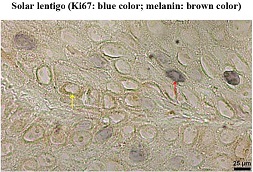Melanin Uptake Reduces Cell Proliferation of Human Epidermal Keratinocytes
Author(s): Xianghong Yan, Ta-Min Wang, Yung-Ching Ming, Yuan-Ming Yeh, Tzu-Ya Chen, Jong-Hwei Su Pang
MELANIN INHIBITED THE IN VIVO KI-67 EXPRESSION IN KERATINOCYTES. THE KI-67 EXPRESSION IN HUMAN
LENTIGO TISSUE WAS REVEALED BY IMMUNOSTAINING THE PROTEIN AND DEVELOPED INTO BLUE COLOR. YELLOW ARROW
INDICATED THE CELL WITH MELANIN UPTAKE AND RED ARROW INDICATED THE CELL WITHOUT MELANIN UPTAKE. REPRESENTATIVE
PHOTO WAS SHOWN FROM FIVE DIFFERENT LENTIGO TISSUES WITH SIMILAR RESULTS.

Melanin, synthesized by melanocyte, is transferred to neighbouring keratinocyte and finally accumulates in perinuclear site. Except functioning as an internal sunscreen to protect from UV damage, the potential effect of melanin on modulating the bioactivity of keratinocyte has not yet been fully investigated. In this study, we added melanin directly to the culture of human epidermal keratinocytes and the uptake of melanin was found to be dose- and time-dependent as determined by spectrophotometric method. The up taken melanin accumulated perinuclear in keratinocytes that is similar to the pattern observed in human solar lentigo tissue by microscopic examination. Pre-treatment of keratinocytes with either niacin amide or trypsin inhibitor reduced the uptake of melanin dose-dependently, indicating a PAR-2-dependent pathway involved. Melanin uptake by keratinocytes inhibited cell proliferation as demonstrated both by the decrease of cell number and nuclear Ki-67 expression. Inhibited Ki-67 expression in melanin-containing keratinocyte was also found in human lentigo tissue. The cell cycle arrested at G1 phase in melanin-up taken keratinocytes was confirmed by flow cytometric method. The protein expressions of cyclin -dependent kinase 1 (CDK1), CDK2, cyclin E, cyclin A and cyclin B were significantly reduced by melanin treatment. Microarray analysis, RT/real-time PCR and western blot demonstrated the inhibited expression of DKK1, a protein known to reduce skin pigmentation, in melanin-up taken keratinocytes. Together, the direct incubation of keratinocyte with melanin might serve as a useful model to study the potential mechanisms involved in melanin uptake and pigmentation process.
0 Comments